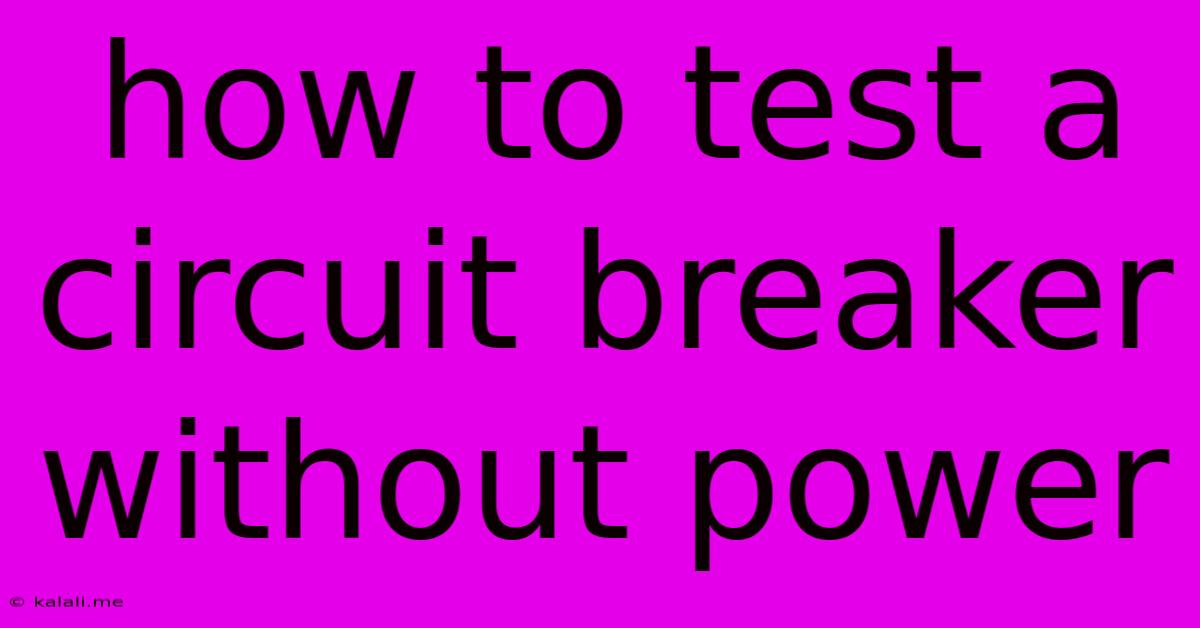How To Test A Circuit Breaker Without Power
Kalali
Jun 06, 2025 · 3 min read

Table of Contents
How to Test a Circuit Breaker Without Power: A Comprehensive Guide
Meta Description: Learn how to safely test a circuit breaker without power using a simple multimeter. This guide provides step-by-step instructions and crucial safety precautions to ensure accurate testing and prevent electrical shocks. Discover how to identify a faulty breaker and avoid costly repairs.
Testing a circuit breaker without power is a crucial step in home maintenance and electrical troubleshooting. A faulty breaker can lead to power outages, electrical hazards, and even fire. Fortunately, you can test a breaker's functionality without needing to turn on the main power supply. This guide provides a clear and concise method to do so, emphasizing safety.
What You'll Need
Before you begin, gather the necessary tools:
- A Multimeter: This essential tool measures voltage, current, and resistance. It's the heart of this testing process. Make sure it's in good working condition.
- Screwdriver (Phillips and Flathead): You'll likely need both types to access the circuit breaker panel.
- Safety Glasses: Always protect your eyes when working with electrical components.
Step-by-Step Guide to Testing a Circuit Breaker Without Power
Important Safety Note: Always ensure the main power supply to your electrical panel is OFF before starting any testing. Double-check the main breaker is in the OFF position. If unsure, consult a qualified electrician.
-
Identify the Circuit Breaker: Locate the specific breaker you want to test within your electrical panel. Note its position and any labels indicating what appliances or circuits it controls.
-
Turn Off the Main Breaker: This is a redundant safety measure, but critical. Ensure the main power switch is completely off.
-
Access the Circuit Breaker Terminals: Carefully remove the circuit breaker from its slot. Most breakers simply push-in and pull-out, while some might require a small release lever.
-
Set Your Multimeter: Set your multimeter to the "continuity test" setting (usually represented by a diode symbol or a bell). This setting checks for the presence of a closed electrical path.
-
Test the Continuity: Touch the multimeter probes to the terminals on the circuit breaker. The terminals are generally located at the top and bottom of the breaker. A closed circuit (meaning the breaker is likely working) will result in a beep or an indication on the multimeter. An open circuit (a likely faulty breaker) will not produce a beep.
-
Interpret the Results:
- Continuous Beep/Indication: This suggests the internal mechanism of the circuit breaker is intact and likely functioning. However, this test doesn't guarantee perfect operation under load.
- No Beep/Indication: This indicates a potential problem with the breaker. It might be faulty and require replacement.
-
Visual Inspection: After the continuity test, carefully inspect the circuit breaker for any signs of damage, such as scorch marks, loose wiring, or physical breakage.
-
Reinstall the Breaker (If Necessary): Once the testing is complete, carefully reinstall the circuit breaker into its slot in the electrical panel. Ensure it’s securely in place.
Understanding the Limitations
This test primarily checks the continuity of the breaker's internal mechanism, not its full functionality under load. A passing continuity test doesn't guarantee the breaker will trip correctly when overloaded or experiencing a short circuit. A faulty breaker might still fail to break the circuit when power is restored.
When to Call an Electrician
If you are uncomfortable performing this test or are unsure about any aspect of your electrical system, it's crucial to contact a qualified electrician. They have the expertise and equipment to properly diagnose and resolve electrical problems safely. Remember, electricity can be dangerous; safety should always be your top priority.
This guide provides a practical approach to testing your circuit breakers; however, remember that professional electrical work is best left to experienced professionals to ensure complete safety.
Latest Posts
Latest Posts
-
What Does The J In Ssj Mean
Jun 07, 2025
-
Car Wont Start One Click Then Nothing
Jun 07, 2025
-
Him Domt Know Where Him Is
Jun 07, 2025
-
Get Your First Image In Knowledge Panel
Jun 07, 2025
-
Has Jennifer Aniston Ever Gone Nude
Jun 07, 2025
Related Post
Thank you for visiting our website which covers about How To Test A Circuit Breaker Without Power . We hope the information provided has been useful to you. Feel free to contact us if you have any questions or need further assistance. See you next time and don't miss to bookmark.